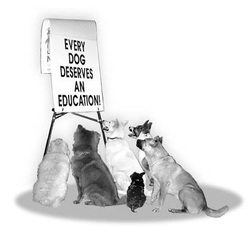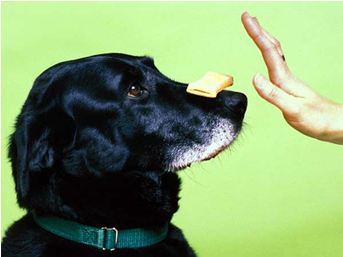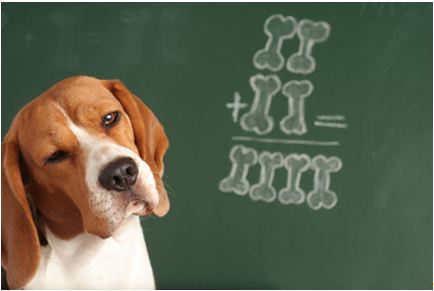UNDERSTANDING DOG TRAINING
by Caroline Mercer.
Qualified Dog and Cat behaviour consultant (OCN)
Petiquette Behaviour & Training Consultations - Rustenburg area
..

There has been an exciting new development in dog training over the years and trainers have become more sophisticated than ever before. Most competent, modern day trainers use a more positive, new age approach to train dogs, which are more effective and more reliable. It creates a successful and enjoyable way for dogs to learn. But, having said that, we must first understand how dogs learn, before we can train a reliable behavior. Read on to discover the principles of training, how dogs learn and what works best when training your dogs.
The basic principles of training involve understanding a few words that are used in the dog training world. There is a lot of misunderstanding when it comes to terminology and it is not always clear what is what. Here, thrown together, is a quick breakdown of what certain terms mean and how they are used in training:
Reinforcement
Occurs when a behavior is rewarded or followed by a consequence, which affects that behavior from happening again. What dogs like, what they will work for and what they avoid. For example treats, a game of fetch, a toy, a cuddle (positive reinforcement). Being reprimanded or locked up in a time out is usually what they want to avoid (negative reinforcement) Good trainer’s base majority of their training on positive reinforcement.
These terms are the most basic terms used in training. There is a lot more involved when it comes to training, but I want to keep this focused on positive training, especially for the owners who want to begin with some form of at home training.
Dogs learn from association and consequence. If something good happens, the behavior is likely to increase in the future. We call this positive reinforcement. So if you make the experience pleasant for the dog, the dog will continue to perform that behavior. If one asks a dog to sit and he sits, he is rewarded with a treat. Sitting was a good consequence and earned him a treat. He will also now associate sitting, with getting something nice.
If something bad happens, this becomes negative reinforcement and good trainers avoid this.
The basic principles of training involve understanding a few words that are used in the dog training world. There is a lot of misunderstanding when it comes to terminology and it is not always clear what is what. Here, thrown together, is a quick breakdown of what certain terms mean and how they are used in training:
Reinforcement
Occurs when a behavior is rewarded or followed by a consequence, which affects that behavior from happening again. What dogs like, what they will work for and what they avoid. For example treats, a game of fetch, a toy, a cuddle (positive reinforcement). Being reprimanded or locked up in a time out is usually what they want to avoid (negative reinforcement) Good trainer’s base majority of their training on positive reinforcement.
- Primary Reinforcer – A Biological reinforce important to a dog like food, water, shelter.
- Secondary reinforcer – Things that are linked to the primary reinforce like a food bowl, water bowl, dog kennel
- Stimulus – An event perceived by the dog. For example a light, a sound, a smell
- Responds or behavior – An action performed by the dog. Walking, lying down, barking
- Consequence – The action or the event that happens AFTER a behavior is performed
- Conditioning – Is straight forward learning
These terms are the most basic terms used in training. There is a lot more involved when it comes to training, but I want to keep this focused on positive training, especially for the owners who want to begin with some form of at home training.
Dogs learn from association and consequence. If something good happens, the behavior is likely to increase in the future. We call this positive reinforcement. So if you make the experience pleasant for the dog, the dog will continue to perform that behavior. If one asks a dog to sit and he sits, he is rewarded with a treat. Sitting was a good consequence and earned him a treat. He will also now associate sitting, with getting something nice.
If something bad happens, this becomes negative reinforcement and good trainers avoid this.
MOTIVATION
Now that we understand a bit more of how dogs learn, we need to understand what motivates them and makes them want to learn. All dog breeds are different and should be treated like individuals. A food crazy Labrador might train more easily with pieces of cheese and viennas rather than a tug-a-rope game. A Staffordshire bull terrier or bull terrier might train better with a game of tug than with a food treat or a swim. A beagle might like a scent game as a reward instead of treats or a game of fetch. So breed difference play a big part and we as owners need to find out what it is that motivates our dogs. This is where good training begins. We can call this drive theory because dogs react differently to training. Motivation is important as learning does not occur without motivation. If a behavior is learned, the dog may not perform it if he is not motivated to respond. Would you go to work every day if you were not paid a salary? Once you have established what your dog likes, then you are ready to begin.
REINFORCEMENT SCHEDULES
Schedules of reinforcements are a rule that determines when and how a response will be rewarded. Once the dog has learned quite reliably what he is expected to perform you can then start to randomize your rewards. Your dog can be rewarded on the following ratios:
Continuous reinforcement schedule (CRF) is when every response is rewarded. When teaching a new behavior for the first time, this is the best schedule to follow. This keeps the dog interested and motivated. As the behavior becomes more reliable, then you can gradually fade out to another reinforcement schedule.
Fixed ratio of reinforcement schedule (FR) is when there is a fixed ratio between the number of responses made and the number of rewards given. Here you could reward your dog every 3rd time. The downfall to this schedule though, is that the dog can begin to anticipate the reward only on every 3rd attempt (yes dogs are that clever) so changing the FR quite often will keep the dog guessing.
Variable ratio schedule of reinforcement (VR) is when the number of responses required for each reward varies from one occasion to another. Slot machines are a good example of this, you are never quite sure when you might hit the jackpot!
You need to start fading out your treats somewhere to avoid the problem where the dog will ONLY work for a reward. You need to be able to ask your dog to do something and have him do it. Nobody wants a dog who will not sit because he is not getting something. Fading out rewards are important and needs to be done. So decide which schedule suits you and your dog best.
Now that we understand a bit more of how dogs learn, we need to understand what motivates them and makes them want to learn. All dog breeds are different and should be treated like individuals. A food crazy Labrador might train more easily with pieces of cheese and viennas rather than a tug-a-rope game. A Staffordshire bull terrier or bull terrier might train better with a game of tug than with a food treat or a swim. A beagle might like a scent game as a reward instead of treats or a game of fetch. So breed difference play a big part and we as owners need to find out what it is that motivates our dogs. This is where good training begins. We can call this drive theory because dogs react differently to training. Motivation is important as learning does not occur without motivation. If a behavior is learned, the dog may not perform it if he is not motivated to respond. Would you go to work every day if you were not paid a salary? Once you have established what your dog likes, then you are ready to begin.
REINFORCEMENT SCHEDULES
Schedules of reinforcements are a rule that determines when and how a response will be rewarded. Once the dog has learned quite reliably what he is expected to perform you can then start to randomize your rewards. Your dog can be rewarded on the following ratios:
Continuous reinforcement schedule (CRF) is when every response is rewarded. When teaching a new behavior for the first time, this is the best schedule to follow. This keeps the dog interested and motivated. As the behavior becomes more reliable, then you can gradually fade out to another reinforcement schedule.
Fixed ratio of reinforcement schedule (FR) is when there is a fixed ratio between the number of responses made and the number of rewards given. Here you could reward your dog every 3rd time. The downfall to this schedule though, is that the dog can begin to anticipate the reward only on every 3rd attempt (yes dogs are that clever) so changing the FR quite often will keep the dog guessing.
Variable ratio schedule of reinforcement (VR) is when the number of responses required for each reward varies from one occasion to another. Slot machines are a good example of this, you are never quite sure when you might hit the jackpot!
You need to start fading out your treats somewhere to avoid the problem where the dog will ONLY work for a reward. You need to be able to ask your dog to do something and have him do it. Nobody wants a dog who will not sit because he is not getting something. Fading out rewards are important and needs to be done. So decide which schedule suits you and your dog best.
DISCRIMINATION AND GENERALISATION
Here there are two processes which are important for training. The dog needs to learn how to discriminate relevant stimuli from all other stimuli that are around when the behaviour is reinforced. When you ask your dog to sit, the dog has to predict that that those words followed by the behavior will be rewarded. A dog can become confused and may, for example, think that the blue sneakers you were wearing are the cue for the behavior. Dogs pick up on things very easily and need to know what cue needs a response without confusing it to something else.
Dogs are very bad generalisers. You can train your dog to sit, roll over and give paw while you are in the garden, but this doesn’t mean that when you take the dog into the kitchen or out for a walk that he will perform the same tasks for you. You need to try and avoid this. Teach your dog the basic behaviours everywhere that you can. When you are at the vet, out for a walk in the park, visiting the parent’s, teach your dogs to perform these in all situations. This will help avoid that confused look when you take doggie to the parlor and all of a sudden he does not know what lie down means.
Here you have a few basic ideas of what needs to be done in training. It is so much easier to begin training when you have a better understanding of a few simple things. So choose what motivates your dog, what reinforcer to use as a reward, which reinforcement schedule to use and when to fade out the treats. Train your dogs in every environment possible and always set them up for success, use positive reinforcement methods, because your dog will always be more successful when trained this way.
Here there are two processes which are important for training. The dog needs to learn how to discriminate relevant stimuli from all other stimuli that are around when the behaviour is reinforced. When you ask your dog to sit, the dog has to predict that that those words followed by the behavior will be rewarded. A dog can become confused and may, for example, think that the blue sneakers you were wearing are the cue for the behavior. Dogs pick up on things very easily and need to know what cue needs a response without confusing it to something else.
Dogs are very bad generalisers. You can train your dog to sit, roll over and give paw while you are in the garden, but this doesn’t mean that when you take the dog into the kitchen or out for a walk that he will perform the same tasks for you. You need to try and avoid this. Teach your dog the basic behaviours everywhere that you can. When you are at the vet, out for a walk in the park, visiting the parent’s, teach your dogs to perform these in all situations. This will help avoid that confused look when you take doggie to the parlor and all of a sudden he does not know what lie down means.
Here you have a few basic ideas of what needs to be done in training. It is so much easier to begin training when you have a better understanding of a few simple things. So choose what motivates your dog, what reinforcer to use as a reward, which reinforcement schedule to use and when to fade out the treats. Train your dogs in every environment possible and always set them up for success, use positive reinforcement methods, because your dog will always be more successful when trained this way.
This article is copyrighted and remains the property of the author. Individuals are welcome to print or copy same for their own use in furthering their knowledge of dogs. However, no reproductions or alterations/variations are allowed without the express written consent of the author.


